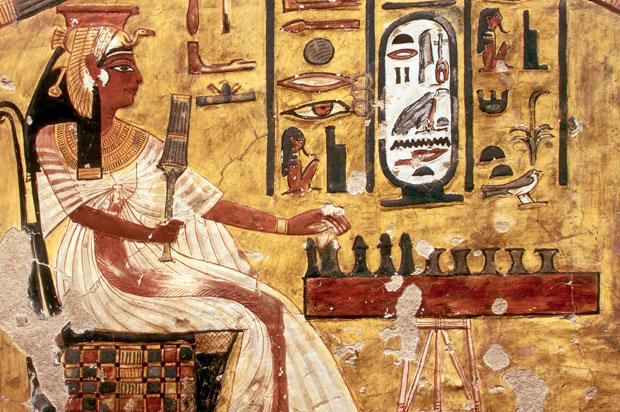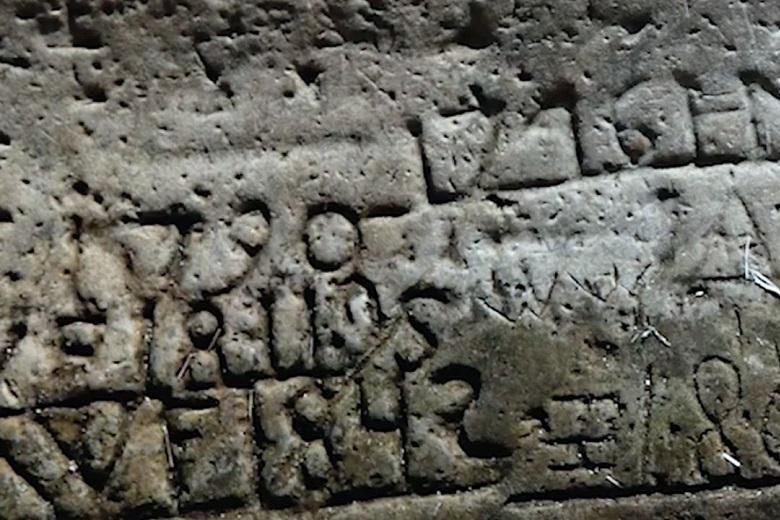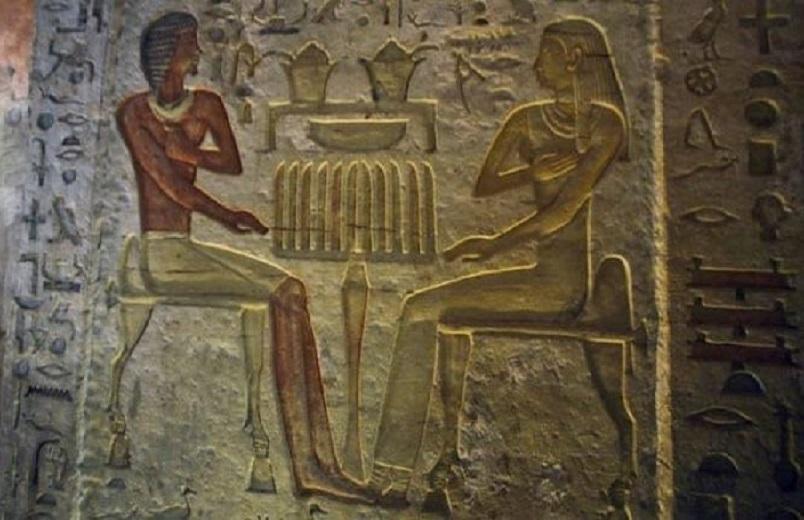Ancient images that reveal new facts: a beardless Jesus, a Pictish handprint, etc.

A wall, petrified dirt, a piece of pottery – all of this can become priceless historical artifacts that can reveal previously known information to archaeologists. From natural disasters to prehistoric hunts, from secret messages to strange-looking Jesus, they’ve all been found on ancient surfaces.
Early Paleolithic art in Burgundy

The Paleolithic marked the earliest cultural development of humankind. In France, communities at the time lived in Burgundy, where they may have even mingled with the Neanderthals.
Over the past 150 years, there has been a lot of evidence that Paleolithic people lived in the Saone-et-Loire area, but scientists could not find their rock paintings in the caves until now, which was extremely strange. However, throughout Europe, Paleolithic monuments have always been accompanied by rock paintings.
In 2018, archaeologists used new equipment to scan two caves (Agneux Caves), which have long been suspected of having hidden ‘decorations.’ In the XVI-XIX, people often visited these caves because of the stunning views that open from them on the surrounding landscapes.
However, these visitors also left behind so much graffiti that the original walls of the cave “disappeared” beneath them. Incredibly, the scan revealed something under centuries-old names, dates, and pictures scrawled on the walls. These turned out to be the first Paleolithic paintings of this region, which depicted a deer and a horse. The analysis found the images to be around 12,000 years old.
Ancient game

Almost the entire ancient middle east played a mysterious game. Unfortunately, its original name and rules have been lost, and today this board game is now called 58 Holes or Hounds and Jackals. More recently, archaeologists have discovered a field for this fun in an Azerbaijan cave.
The bottom of the cave was dotted with holes made by local nomadic herders. Incredibly, the stone field for the game was about 4,000 years old; that is, it is as old as the “58 holes” set found in the Pharaoh’s tomb, dating back to the 18th century BC.
Some people think that 58 holes are the ancestor of backgammon, but this is a myth. Instead, backgammon evolved from the much younger game of tabula, which the Romans invented.
The oldest modern name for Jerusalem

In 2018, archaeologists were invited to check any historical artifacts on the site during the construction of a new road. Surprisingly, scientists have found an ancient ceramic workshop. But this was not the most exciting thing.
The Roman building was erected in part from building materials taken from other structures. For example, analysis of one of the columns showed that it was made around the reign of Herod the Great (37–4 BC), but it also had a slightly younger inscription.
The inscription, carved in the first century AD, read in Aramaic: “Hananiah, son of Dodalos from Jerusalem.” We can only guess who these two people were. But the name of the ancient city was an exceptional find. Usually, an abbreviated version was used in ancient scriptures and artifacts – they wrote: “Yerusalem” or “Shalem.” The name was spelled the same as in Hebrew today – “Yerushalayim,” making it the oldest ever found. Among the artifacts of the first century, there is only one such example – the name was minted on a coin dated 66-70 AD. AD
Hunger stones

In recent years, drought has led to a decrease in the river level in the Czech Republic near the town of Decin. At the same time, as a result of the fall in the water level, large stones with inscriptions dating back to the 1600s were discovered.
The inscriptions on 12 stones were, to put it mildly, not joyful. They talked about the drop in the water level in the Elbe River and the difficulties caused by the drought. Therefore, it is not surprising that soon the finds received a proper name – “hunger stones”.
One person wrote about missing crops, high prices, lack of food, and the fact that the poor were doomed to starvation. On the same stone was written in German: “W hen you see me, cry.”
The oldest boulder dates back to 1616, making it one of the oldest of its kind in Central Europe. While current droughts are considered some of the most extreme, they are still weaker than those that have ravaged Europe over the past few centuries.
Life of a priest

One of the best Egyptian treasures discovered in 2018 was the tomb of a priest of the Pharaoh. And what made this find so exciting was that the two-level tomb was not looted and was filled with statues and colorful images. Wall surfaces and artifacts told the story of the priest Vakhtye, his family, and the world he lived in.
The priest served Pharaoh Neferirkare during the Fifth Dynasty, which lasted from 2500 BC. until 2350 BC. The 4400-year-old building was also in perfect condition. Images 10 meters long, 3 meters wide, and 3 meters high were everywhere. They showed people making ceramics, wine, and funerary furniture.
Other scenes featured hunting and sailing, as well as musical and religious themes. The tomb, located south of Cairo, still needs full exploration. For example, archaeologists expect to find the body of Vakhtye himself.
Ancient handprint
In Scotland, archaeologists face a major challenge. Archaeological excavations associated with the Picts are considered valuable because almost nothing is known about this culture (300 BC – 900 AD). But now, the sea is slowly “reclaiming” land areas with priceless artifacts and ruins. During a recent excavation at the Orkney Islands, the team found an ancient forge. The building was once underground and contained a swinging stone door, a round room with a hearth, and two large anvils made of huge stones.
While cleaning one anvil, a dark handprint was found. Initially, the researchers believed that the imprint was made during excavations. However, it soon became clear that he was ancient.
About 1,500 years ago, a man leaned on a stone anvil with a hand smeared with coal dust. Until now, nothing like this has ever been found, all the more so that it refers to civilization so “elusive” that the Picts are often called “the lost people of Europe.”
Sloth hunting
In 2017, fossilized human footprints were found in the White Sands National Monument Park in New Mexico. During a 2018 survey, evidence of an ancient hunt was found here. This conclusion was made because the human footprints were inside the larger sloth tracks. The find was about 11,000 years old.
Their age and lack of other evidence made it difficult to decipher the event. However, there were some clues as well. Finding human prints inside animal prints means people were following the fresh trail of a sloth.
At some point, the sloth tracks showed that the animal got up on its hind legs, made a stance, and attacked the hunters.
Modern sloths are vulnerable creatures that cannot fight. But the ancient giant sloth was deadly. Standing on its hind legs, it was 213 centimeters tall, had a muscular body and long limbs armed with sickle-shaped nails. It is doubtful that the stone weapon could have killed the beast, but the find proved that humans were hunting giant sloths, a species that later became extinct.
Ice Age
Thousands of years ago, humanity experienced a mini ice age. It received the name “younger Dryas” and lasted for about 1000 years. Researchers have long suspected that a comet caused this catastrophe, but no evidence has supported this theory. In 2017, archaeologists studied the symbols at Göbekli Tepe in Turkey, considered the oldest temple complex in the world (9000 BC).
The carvings on one of its pillars seemed to have been carved in memory of the terrible event. Known as the Vulture Stone, this pillar was carved with animal images and showed the Earth being swept over by a stream of comets. The meaning of this picture remained unclear until recent research.
It is noteworthy that the position of the animals corresponded to the constellations in the sky. This allowed scientists to accurately determine the date with an error of about 250 years. The theory of a comet crashing into Earth was confirmed when that date coincided with the beginning of the Younger Dryas. Exploration of ice in Greenland suggested that the millennium of frost began around 10,890 BC, and the symbols on the Vulture Rock depicted the sky around 10,950 BC. It could also change the long-standing belief that Göbekli Tepe was just a temple. It was probably also an observatory.
Beardless Jesus

In the 1920s, archaeologists excavated an ancient church in Israel. At the ceiling in the area of the baptismal site, they found an extremely fuzzy picture. In 2018, an archaeologist decided to investigate its faint lines and was surprised to find on the wall the face of… a beardless Jesus.
Unlike the classic long-bearded image, familiar to everyone from the icons, the clean-shaven man also had a long nose and curly head. But even the unusual appearance of the figure alarmed the archaeologists.
There are several old pictures of the baptism of Jesus in the Holy Land. But among them, there is not a single one older than the era of Iconoclasm (VIII-IX centuries). The earliest age of the painting is about 200 years after the crucifixion. This makes the find old enough to be considered the first of its kind.




